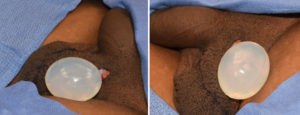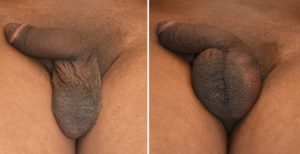Background: The loss of a testicle can occur for many reasons and can present as a more recent or long-standing absence. It is far more common in my experience to see men that have been missing a testicle for years or decades as opposed to just a few months from its removal.
The absence of a testicle removes an expansile force that will cause the scrotum tissues to shrink. This is somewhat similar to a breast implant capsule and what happens when the implants are removed. The difference is that the fascial tissues surrounding the testes (tunica albuginea and tunica vaginalis) have always been present and have a distinct blood supply. Thus they never really completely disappear (unlike a breast implant capsule for example) when the testicle is removed. They shrink and contract for sure but remain present.
When replacing a testicle that has been lost for a long time, the one side of the scrotal sac will be considerably smaller than the side in which a testicle resides. This is, of course, expected but does factor into how a testicular implant is replaced into it. As a general rule one should not expect the implanted side to hang as low as the other side. Because of this expected (and normal) testicular scrotal asymmetry, the choice of the size of the implant should be no larger than the other side or even just a bit smaller.
Case Study: This young male had lost a left testicle as a teenager twenty years previously due to testicular torsion.


Highlights:
1) Loss of a testicle can be replaced decades later if desired.
2) Long-standing testicular loss usually results in some contraction of the scrotal sac which may not stretch fully to the opposite side where a testicle has always resided.
3) It is usually best to choose the same or smaller testicle implant size due to a potentially tighter scrotal sac that may develop less implant drop.
Dr. Barry Eppley
Indianapolis, Indiana


